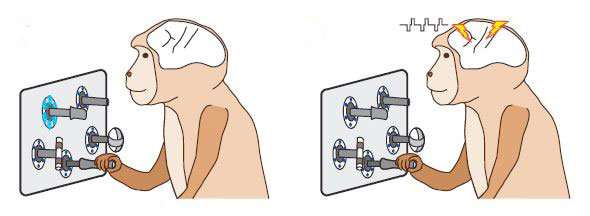Monkey feel, monkey do: Microstimulation in premotor cortex can instruct movement

Like an appliance with faulty wiring, injury and disease in the brain can result in lost connections, wreaking havoc on critical functions like perception and movement. Finding ways to get around those broken networks is an important area of research for those seeking to develop treatment interventions. Now researchers are showing in monkeys that stimulation delivered directly to the premotor cortex can elicit a feeling or experience that can instruct different movements, even when the stimulus is too small to induce any response directly. The study appears December 7 in the journal Neuron.
"Researchers have been interested primarily in stimulating the primary sensory cortices—the somatosensory cortex, visual cortex, and auditory cortex— to input information into the brain," says Marc H. Schieber, a physician and researcher at the University of Rochester and the study's senior author. "What we are showing here is that you don't have to be in a sensory-receiving area in order for the subject to have an experience that they can identify."
In the experiment, the monkeys were trained initially to execute a task in which they associated a particular visual instruction—a light surrounding one of four objects being turned on—with a particular movement. They started the trial by holding a handle in a central position. When they received the light instruction, they would manipulate the associated object with their hands.
At the same time the lights were going on, the monkeys received very low levels of electrical stimulation, insufficient to directly elicit a response in the premotor cortex, an area not normally associated with perception. A different point of stimulation in the brain was associated with each of the four lights and movements. Gradually the lights were taken away, but the monkeys continued to do the correct movements when they received the microstimulation. They had learned to associate the experience of having a particular area in the premotor cortex stimulated with a particular movement.
"The monkeys can't tell us what they are feeling, so training them to associate the microstimulation with a movement is the way we are able to confirm that they have felt an urge or had some kind of experience," Schieber says.
To further eliminate the possibility that the stimulation was directly eliciting the movement by triggering the nerves in the arm and hand, the researchers then shuffled the assignment of the different electrodes and retrained the monkeys with the lights. For example, the electrode in the location that previously had been associated with pushing a button became associated instead with turning a handle. When the lights were again removed, the monkeys had associated the different areas of microstimulation with the reassigned movements.
The investigators say the research has implication for the development of brain/computer interfaces and ultimately neuroprosthetics.
"Most of the work in the development of brain/computer interfaces has focused primarily on the sensory area of the brain. But that confines where in the brain you're able to deliver the information," says first author Kevin A. Mazurek, a postdoctoral fellow in Schieber's lab. "In this study, we show you can expand the neural real estate that can be targeted with therapies. This could be very important for people who have lost function in areas of their brain due to stroke, injury, or other disease. We can potentially bypass the damaged part of the brain where connections have been lost and deliver information to an intact part of the brain."
A next step for the research is to try this type of low-amplitude microstimulation in humans. "When you stimulate the somatosensory or visual cortex directly, the subject typically feels something on their skin or sees something in their vision," Schieber explains. "This shows you may be able to deliver the desired information to a person's brain without these perceptions."
He adds that more animal research is important as well, to continue to identify additional parts of the brain where microstimulation evokes distinguishable experiences.
More information: Neuron, Mazurek et al. "Injecting Instructions into Premotor Cortex" www.cell.com/neuron/fulltext/S0896-6273(17)31034-6 , DOI: 10.1016/j.neuron.2017.11.006
















